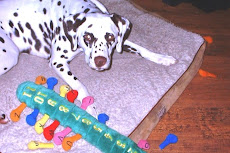It seems no matter where I go someone will comment on how much they enjoy my blog. That's so nice to hear and I'm amazed at how many have found this blog! I write because I enjoy it, but also in hopes of educating and providing some entertainment. Although I don't see myself writing another book, writing is one of the things I really enjoy, and blogging provides a perfect outlet.
A recent posting generated several questions on blood panels. Yes, I do recommend blood panels for more than just older dogs. Because a basic panel can be run when a dog has a heartworm test, yearly panels are ideal. At least one panel before middle-age will also provide baseline readings. We always do a blood panel before breeding a bitch, and any dog being used at stud gets one twice year. BUN & Creatinine levels will be elevated in dogs with kidney issues, although most dogs do very well until the kidneys are functioning at no more than 25-30%. The sooner the owner is aware of kidney issues, the sooner adjustments can be made to prolong the dog's quality of life.
A number of readings can reflect liver issues, and because the liver (unlike the kidneys) has the ability to heal itself, it's very useful to know if there are issues that should be treated. One of the problems occasionally seen in the breed is Copper Toxicosis or Copper Storage Disease. An elevated ALT can indicate that copper is accumulating in the liver, and this can be confirmed with a liver biopsy. Without treatment CT is fatal, but if properly diagnosed it can be treated with daily medication.
Just a simple WBC (white blood cell count) can indicate an infection that may be festering. For example, an unspayed bitch with pyometra may show a very elevated WBC before the owner notices any other symptoms, and unless treated promptly this is a killer. For that reason, if a dog is acting "off" but there are no obvious physical symptoms, a blood panel is well worth the cost, if only for the owner's peace of mind.
One thing to note is that the normal ranges are based on what is normal for (grain-based) kibble fed dogs. The BUN & Creatinine levels may be a bit higher on normal raw fed dogs, although it varies from dog to dog and may also depend on what the diet is based on. I knew that Antech was involved in a study that proved this, so Googled the topic and found this excellent article. http://www.canine-epilepsy.com/doddsnutrition.html
If you notice that the page is hosted on an epilepsy website, it's because many dogs that seizure do extremely well when taken off a grain-based diet and switched to a raw diet. Please note that even though your kibble of choice may show meat as the first ingredient, the other ingredients are probably various forms of grain and total more than the actual meat in the food. Just removing any form of processed grain often makes a huge difference for dogs with epilepsy.
Subscribe to:
Post Comments (Atom)
















































No comments:
Post a Comment